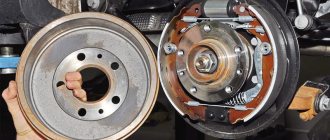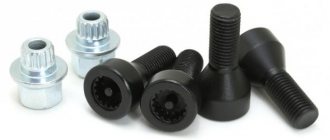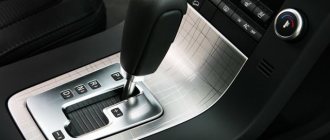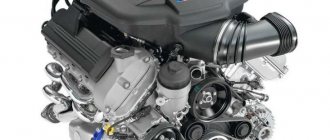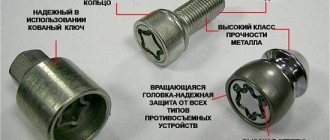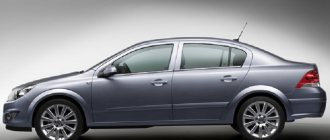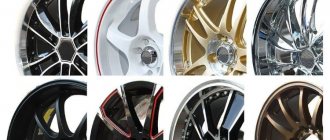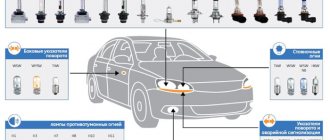Wheel caps are a fairly popular car accessory. Such a seemingly insignificant detail can significantly change the appearance of your car. However, not everyone knows how to choose wheel covers and what they are needed for.
It is worth noting that such products not only have a decorative function. In addition to beauty and style, decorative wheel covers protect the car, namely its brake system and discs, from dirt, ice, snow and dust. This increases the service life of these parts.
It happens that manufacturers put original car hubcaps on wheels, but in this case consumers do not have a choice of the type of product. And the cost of such accessories is much higher than the price of non-original variations.
Fastening hubcaps to discs
Car wheel covers are a fairly popular accessory.
They perform not only a decorative function, but also protect the brake system from dirt and slush, especially in winter, when the car’s wheels have a hard time. They are made mainly from elastic plastic with a high degree of viscosity. This material easily withstands low temperatures and does not crack from any impact. Although on sale you can also find non-original low-quality products made of durable but fragile plastic, which is unlikely to last long. Caps made of aluminum and even rubber are also sold, but they are practically not used due to the high price.
The caps are designed to imitate alloy wheels. If you have chosen beautiful and fashionable hubcaps, then it is almost impossible to distinguish them from alloy wheels from a distance.
Their configuration may be different - the number and shape of the spokes, but if you try to classify the types of caps, they can be divided into several groups:
- open and closed - open, obviously, are used only for decorative purposes, with their help you can hide disc defects;
- flat and convex - convex caps extend beyond the plane of the wheel and can be very easily lost on narrow city streets, while flat caps are easy to install and functional.
How to install hubcaps on wheels?
Installation of the cap is possible in several ways, depending on the type of fastening:
- using latches;
- bolted connection;
- on plastic clamps.
Craftsmen, of course, can offer a huge number of other methods, for example, placing the caps on instant glue, or using homemade rubber “mushrooms” that are placed on the wheel bolts, and then plastic clamps are threaded through them to secure the cap.
It is worth saying that if you take this accessory correctly, and at the same time it is original, and not some cheap fake, then it will fly off only under very strong external influence.
If you bought a set of caps in a company store, then most likely the fastening will be on latches - these are 6, 7 or 8 tabs on the inside, onto which a spacer ring is placed, the diameter of which matches the diameter of the disk. The spacer ring has a spacer that must align with the nipple.
The entire installation process boils down to the fact that you install this ring between the presser feet on the inside of the cap. Combine the recess on the ring with the nipple and with a little force press this entire structure to the wheel. The expansion ring will take its position in the groove of the wheel rim and securely fix the cap with the help of latches. For reliability, you can additionally use plastic clamps: pull them through the holes in the wheel rim and fasten them to the spoke of the hubcap, cut the ends of the clamp so that they are not noticeable.
You can then remove such a cap without any problems using a screwdriver or the ignition key - just pick up the release ring. But while driving, they can only get lost on a very bad road, or if you hit a curb.
If you bought caps with bolts, you will have to completely remove the wheel and then screw it together with the cap. There are also models that have grooves on the inside that fit the wheel bolts, you combine these grooves with the heads of the bolts and press on the cap, it fits firmly into place.
Recommendations for selection
Having studied all the existing varieties of wheel decorative elements that cover the rims, as well as having understood their strengths and weaknesses, you can think about how to choose the right wheel covers for your car.
In fact, selecting such kits is quite simple. It is important here that the products you choose fully comply with the requirements in terms of appearance, and are also suitable in size for the wheels of the vehicle. Therefore, before choosing hubcaps and installing them on your wheels, it’s a good idea to double-check the tire size. Otherwise, incorrectly selected sets will have to be returned to the seller, which is not always very easy. The buyer, when choosing a set of decorative caps, must first know the minimum information about the wheels themselves that are installed on the car.
First of all, start with the size. Everyone knows that wheels are offered in different sizes and with different radii, measured in inches. Depending on the specific size, tires are marked R13, R14, R15, etc. If you have 15-inch wheels, then the caps are chosen with the corresponding marking R15.
It is impossible to say accurately and objectively which wheel covers are the best, and why some products are better or worse than others. Although metal kits are definitely not a priority now. They weigh a lot, are expensive, and do not have the desired practicality, unlike their plastic counterparts.
Having decided on the size, move on to the design features. If there are no visible defects on the rims, it would be logical to choose open caps. They look most impressive against the backdrop of black wheels that show no signs of damage. Plus, open kits are more diverse in terms of design solutions; various complex and simple patterns are used here, which look equally beneficial on the car if chosen wisely.
If you have open-type caps that have a rather bold and aggressive appearance, then they will look good on a sports vehicle. Or with external features characteristic of sports cars. But in combination with some kind of family car or city hatchback, the result will not be particularly attractive. When buying a set of products for a classic sedan or station wagon, give preference to a less pronounced design and smooth lines. Aggression and too bright patterns for cars without sporting characteristics will be objectively unnecessary.
If the discs are unpainted, or if there are noticeable defects, it is better for you to avoid open types of caps, choosing a suitable option among closed designs.
Don't forget that the material from which they are made plays a big role in purchasing quality wheel covers. It’s not enough to just know whether plastic or metal was used.
Metal-based products are not particularly popular. And there are a number of objective explanations for this. But you should also not buy caps that use too hard plastic. To some, increased hardness may seem like an advantage, but it is not. In fact, a high degree of hardness exhibits an important disadvantage of plastic in the form of increased fragility. This means that even with minor impacts and mechanical stress, the plastic lining on top of the wheel rim can crack and crumble. A similar thing will happen if road debris, small stones and crushed stones get into the hood. Gradually the surface will become covered with small chips and cracks. The kit will have to be changed completely.
Likewise, a cap made from overly soft plastic would be a poor choice. Increased plasticity and elasticity causes such products to fly out of their seats when driving over bumps, potholes and small holes. The fastening tabs will not be able to effectively hold the structure on the wheel, thereby significantly increasing the likelihood of losing the cap while driving.
The best choice would be plastic with a medium degree of hardness. Checking the quality of the material with your own hands is not difficult. You can do a small experiment yourself while in a store and choose a set from a wide range of products. You will simply need to manually test the strength of one of the presser feet. Try to bend it with your fingers. If movement is immediately felt, even with little force, the plastic is too soft. If, with great force, the presser foot does not mix at all and remains motionless, excessively hard plastic is used here.
Many manufacturers indicate what kind of plastic they use to make decorative products for car wheels. Here, German and Polish plastic is considered the most preferable. Korean and Taiwanese plastics are of slightly lower quality. The materials demonstrate excellent wear resistance and are not afraid of contact with aggressive substances.
The next point of choice is the shape of future hubcaps for your vehicle. Experts and simply experienced motorists with extensive experience in operating wheel covers advise choosing designs with a slightly convex shape. They look much more impressive and attractive, plus it will be more problematic to damage them when they come into contact with curbs. After all, due to the slight convexity, they do not extend much beyond the wheel, thereby minimizing the risk of damage.
Bolt fastening is considered more reliable than using latches. But it is important to take into account that the mounting axles on the wheel itself coincide with the holes on the decorative product. Otherwise, you simply will not be able to install the cap correctly on your car.
An impressive proportion of the kits offered come with latches as fixing elements. If you have correctly taken into account the dimensions and chosen the appropriate strength of the plastic, such structures should not fly off. But still, for reliability, it is recommended to supplement the fixation with invisible clamps or special hooks. Or go with bolted caps, carefully selecting the hole ratio.
Bolted connections take longer to install, but are also more difficult to remove. This is an additional measure of protection against vandals and hooligans who quite often play around and remove the hubcaps from cars. Some do this purely for the sake of profit, while others are engaged in banal hooliganism.
If you still prefer caps with latches, pay attention to the number of latches. It is optimal to buy a set of wheel covers that use at least 6 clamps around the perimeter of the product. The more latches there are, the better and more reliable the connection will be.
Description and meaning of caps
Wheel covers are a very popular accessory today. These devices perform a decorative and protective function. They protect the brake system from slush and dirt. Such protection is important during the cold season. At this time, the load on the brakes increases.
Wheel caps are made from various materials. The most commonly used material is plastic. But such material comes in different qualities. Therefore, not all products have high viscosity and elasticity. Accessories with such characteristics resist shock, deformation and cold well.
Caps are also made of metal. Such products are durable and reliable. But it is very difficult to give such material a beautiful and elegant shape. Metal caps rust quickly. This spoils the appearance of the car.
There are rubber products. They adhere perfectly to the wheels, do not break, and also visually reduce the rubber profile and increase the radius of the disc. Metal and rubber caps are very rare.
Additionally, we recommend reading our expert’s article about which wheels are better – cast or forged.
We also recommend that you study an article by a specialist that talks about how to properly store tires in winter and summer.
You may also be interested in material on how to make snow bracelets with your own hands.
The configuration of the caps is different. It depends on the shape and number of knitting needles. There are also products:
- open . Used for decorative purposes. They allow you to hide disc defects without the risk of brake overheating;
- closed . They protect brake pads and discs well from dirt. They reduce the flow of air to the brake system when driving, which can lead to overheating over long distances.
The shape of the caps is made convex and flat. Products of the first type protrude beyond the plane of the wheel. Therefore, they are easy to lose when driving. But they look impressive. Flat accessories are functional and easy to install.
How can they deceive?
Any vehicle is sold without hubcaps. However, the dealer can install them for an additional fee. Their cost is significantly inflated. In addition, the buyer cannot choose a quality accessory due to the limited range. The car may be put up for sale already with hubcaps, but you will have to pay exactly for them. This factor is beneficial to the dealer, and not to the future owner.
Therefore, when buying at a car dealership, it is better to refuse to purchase hubcaps. It is better to spend extra time and choose a quality accessory. Caps for stamped wheels are very popular. Many vehicle owners purchase several sets of wheels. The first one is used for movement in the warm season, so the wheels can be alloy. The second set is used in winter. Stamped wheels can withstand any adverse road conditions.
How to choose the right one
The range of car hubcaps on the market is huge. Therefore, you need to know what to look for when choosing such an accessory.
First you need to decide on the size. If the wheel has a size of 14 inches, then you should choose an accessory marked R14. The dimensions of the cap must be identical to the diameter of the disk. The most popular accessory sizes are from R12 to R16. The holes for installing products must coincide with the grooves on the disk.
When choosing, the design features of wheels and disks are taken into account. If the discs are black and do not have obvious visible defects, then you can buy open-type caps of any pattern. For sports cars, accessories of aggressive design are suitable. For standard cars, it is better to buy classic products.
Features of open and closed types
The advantages for car enthusiasts include:
- Effective cooling of brake discs;
- Possibility of excellent ventilation of brakes;
- Elimination of overheating;
- Diversity – constructive, styles and designs.
Minuses:
- Poorly protect the disc from moisture and fine dirt;
- Do not mask or cover up damage to disks;
- Used for wheels without visible defects.
Open products are purchased if, first of all, there is a goal to preserve the brake system, because these types have large ventilation holes through which the brake system will be cooled and at the same time will increase the aesthetic appearance of the wheel.
Closed hoods have great advantages:
- Excellent protection against water, dirt and debris;
- Prevents corrosion and rust;
- Protects against wear;
- Reliably hide disc defects;
- Easy to clean;
- Self-cleaning from contamination;
- Wide variety of species.
Minus - they do not ventilate well and remove heat from the brake mechanisms; they do not help prevent overheating.
In hot weather, if the car is used actively, then closed caps will not help prevent boiling and overheating of the brake system.
How to install to disks
Wheel caps can be installed in several ways. Let's look at each method in more detail.
Using latches
If you purchase an accessory in a company store, then most likely it will be secured with latches. Fastening elements are placed on the inside in the amount of 6 - 8 pieces.
First, a spacer ring is placed on the fasteners. Its diameter must coincide with the same parameter of the disk. The spacer ring has an expansion space. It should match the nipple.
The process of installing caps with latches comes down to installing a spacer ring between the inside of the product and the clamping fasteners. Next, the holes are aligned with the nipple. It then takes a little force to press the structure onto the wheel. If everything was done correctly, the expansion ring will take the desired position in the disc groove. As a result, the cap will be firmly fixed to the wheel.
This installation method is considered simple if the product is equipped with at least 6 latches. The stiffness of the locking springs is also important. If it is small, then the fastenings will become loose over time. If the rigidity is high, then the caps will be difficult to remove.
Bolted connection
Fastening with bolts is considered the most reliable. But it is the least convenient in terms of installation and removal of accessories. To install bolt-on hubcaps, you must completely remove the wheel from the car.
There are models that have special grooves on the reverse side. They correspond to the location of the wheel bolts. During installation, the grooves are aligned with the bolt heads and firmly fixed.
On clamps
If none of the above fastening methods are suitable, plastic clamps may be used. They are pulled through the holes in the wheel disk and the cap at the point of fixation. Then the clamps are simply tightened. Installation takes only a few minutes. If you need to remove the accessory, the clamps are simply cut. Therefore, they are considered disposable retainers.
How to properly install wheel covers - tips from Avtoforma.com store
Today the topic of our meeting will be the installation of such a useful device as wheel caps on a car. It would seem like a simple element of the exterior, a beautiful piece of plastic, easy to install. But no, and some “lucky” people have probably already been able to verify this from their own experience. It turns out that if the installation of the caps is carried out incorrectly, they, even the highest quality ones, can crack, and the mounting latch may break. And joy after such an incident, of course, will not increase. So how to do everything right?
Install the spacer ring on the caps
So, let's start with the simplest thing - make sure that the radius of the hubcaps matches the radius of the wheels of your
car. After this, we remove the caps one by one from the packaging and install a spacer ring in each. Its function is important - thanks to it, the wheel caps are held very firmly. On some manufacturers' hoods, spacer rings are installed on the conveyor. We will assume that you happened to buy wheel caps without installed rings. It should be noted that the fact of installed/uninstalled rings does not indicate (in our experience) the quality of the caps themselves.
Wheel covers - what's the use of them?
Car wheel covers are designed primarily to improve the appearance of the car.
In addition to the decorative function, these car accessories perform a small protective function. They protect wheel rims from the impact of road surface elements (crushed stone, gravel). The caps also partially prevent the entry of dust and sand, which has a positive effect on the service life of the brake pads.
Another protective function of car hubcaps is that they are located on top of the disc, and in the event of a possible side impact on the wheel in a collision, for example, with a curb, the cap itself will most often be damaged, as well.
Based on this, we can note a number of positive qualities of wheel covers:
- They decorate the exterior of the car quite well;
- Do not allow dirt and dust to get on the discs and settle on them;
- The caps protect the rims from the impact of stones flying from under the wheels;
- They are the first to absorb a side impact on the wheels, protecting the disc itself from damage;
- The caps have a relatively low cost.
Correct installation of wheel covers
We begin the installation with what has already been mentioned - we combine the bend under the valve with the valve itself and press the cap to the disk in this exact place.
Next, one by one, pressing the edge of the cap, insert each latch into the disk. The force should be sufficient to press the latch into the disk, but this must be done carefully so as not to damage the cap. Excessive pressure with your hands may cause it to burst. The same thing can happen if you press all the latches into the disk at the same time. Therefore, we snap each one in turn.
When you are sure that all the latches are in place, try, holding the opposite edges of the cap, turn it a little on the disk, and tug. That is, you need to make sure that the cap is in place and will not jump out on the road. By the way, drivers encounter this problem—loss of hubcaps—quite often. And in order to avoid it, you can use plastic clamps. Usually the average length of the clamp that will suit you is 30-35 cm, the width is usually 3.5-4.8 mm. Clamps come in black and white. They cost pennies, but their benefits are many times greater. Imagine yourself, you bought hubcaps and one flew away on the road. And that’s it, again you need to buy all four wheel covers.
By the way, in the Avtoforma.com store you can order caps individually
— We try to help our clients out.
Here are all the instructions for you. Although many of our clients have long been advanced drivers, we hope that many will find it useful. Anyway we tried
.
Installation of car hubcaps
Do you want to know how to install hubcaps on the rims of your car so that they do not fly off and remain intact during installation - read the clear step-by-step instructions with pictures and videos
Before installing the wheel covers, make sure that their size matches the size of the rim (Figure 1). Information about the rim size can be obtained from the markings on the tire.
Point 1. First you need to thoroughly clean the inner surface of the disk from dust and dirt. If there are significant deformations of the wheel rim, they must be eliminated by straightening.
Step 2. Align the valve notches on the cap and spacer ring (Figure 2). The bend on the spacer ring should be facing towards the wheel cover (as shown in Figure 3a). Carefully fix the spacer ring into the specially designed grooves located on the inside of the wheel cover latches.
Point 3. It is necessary to adjust the diameter of the spacer ring by compressing it at the valve location if the cap fits tightly (Figure 4 a), or by stretching it when the cap fits loosely (Figure 4 c). Correct adjustment of the diameter of the spacer ring is the main secret of reliable fastening. The small diameter is the main reason for the loss of the cap (after all, it does not sit tightly in the disk). An excessively large diameter becomes one of the reasons for clip failure due to the inability to insert it into the disc.
When adjusting the size, do not try to change it too much; 2-3 mm along the circumference can greatly affect the reliability of fastening
Step 4. Attach the wheel cap to the bottom of the rim so that the hole coincides with the air valve (thanks to this, the cap will be installed correctly the first time), hold it with your knee, and carefully insert the remaining fasteners into the wheel rim. Press the two upper latches with your fingers towards the axis of the disk (Fig. 5) and at the same time press them inside the disk, pressing the wheel cap all the way around the disk. It is convenient to hold the lower part of the cap with your knee (Fig. 6).
The trick is that if the upper latches are not directed inside the disk with your fingers , and the spacer ring is in a tense state and tries to push them out, then you risk breaking one of the fastening clips . Clips break much more easily in the cold, so in winter, we recommend installing them in a warm garage. If there is no “warm installation” option, simply warm the hoods to room temperature in the room before installation.
